Solar Water Treatment Plant
Menu
Product introduction
Introduction to Solar Water Treatment and Purification Plant
The intelligent distributed solar water treatment and purification plant is an environmental protection equipment that integrates solar photovoltaic power generation technology, efficient drinking water and domestic sewage treatment technology, and is equipped with leisure or office area and bathing related functions. It aims to use renewable energy to coordinate the treatment of drinking water and sewage. While achieving efficient resource utilization and sustainable environmental development, work, leisure and life needs are also solved in one stop.
The solar water treatment and purification plant is divided into two products: Drinking Water Purification Plant and Domestic Sewage Treatment Plant. The overall equipment is all modular, and some products are equipped with auxiliary expansion function modules according to user needs. The whole system equipment is intelligently managed to achieve unmanned and fully automated operation.
Composition of drinking water purification plant
The intelligent distributed solar drinking water purification plant is a comprehensive water supply treatment system equipment with well water, river water and natural lakes as water sources. It is mainly composed of the following key modules.
1. Solar photovoltaic panel power generation module:
This is the energy supply core of the system. It directly converts solar energy into electrical energy through the photovoltaic effect to provide power for the entire sewage treatment system. The area and number of photovoltaic panels depend on the energy consumption requirements of the treatment system. The solar photovoltaic panel power generation module has a folding function.
2. Battery group energy storage power supply module:
It is used to store the electricity generated by solar photovoltaic panels when there is sufficient light, ensuring that the system can continue to operate stably in the case of insufficient light at night or on cloudy days. The power supply battery adopts stacked batteries, such as stacked lithium batteries, stacked colloidal batteries, stacked lead-acid batteries, etc.
3. Diesel power generation system module:
It is equipped with high-performance, unattended intelligent generators to meet the power demand on rainy days or when there is insufficient light, so as to ensure the stable and reliable operation of the system device.
4. Ceramic membrane pretreatment system module:
This module system adopts first-line brand inorganic ceramic membrane with a filtration accuracy of 0.1μm, which can effectively remove suspended matter and colloidal substances. This module mainly includes: reaction water tank, water production tank, water production pump, backwash pump and offline cleaning system, process pipeline and pipe fittings valve, fully automatic operation management control module, etc.
5. Reverse osmosis deep purification system module:
The product configuration is advanced and adopts first-line brand reverse osmosis RO membrane. The purification system adopts multi-stage filtration and disinfection to meet the water use standards of drinking water to meet daily drinking water needs. Mainly includes: raw water pump, security filter, high-pressure pump, membrane assembly and bracket, offline cleaning system, process pipeline and pipe fittings, valves, fully automatic operation management control module, etc.
6. Control system module:
It usually includes microcomputer control system and remote communication system, which is used to automatically monitor and manage the entire sewage treatment process, including aeration time, reflux ratio, equipment operation status, etc., to achieve efficient and energy-saving automatic operation. The remote communication system allows remote monitoring and fault diagnosis, which is convenient for real-time management and maintenance.
Composition of domestic sewage treatment plant
The intelligent distributed solar sewage treatment plant is a comprehensive environmental protection treatment equipment, mainly composed of the following key modules:
1. Solar photovoltaic panel power generation module:
This is the energy supply core of the system. It directly converts solar energy into electrical energy through the photovoltaic effect to provide power for the entire sewage treatment system. The area and number of photovoltaic panels are determined according to the energy consumption requirements of the treatment system. The solar photovoltaic panel power generation module has a folding and stretching function.
2. Battery group energy storage power supply module:
It is used to store the electricity generated by the solar photovoltaic panels when there is sufficient light, ensuring that the system can continue to operate stably in the case of insufficient light at night or on cloudy days. The power supply battery adopts stacked batteries, such as stacked lithium batteries, stacked colloidal batteries, stacked lead-acid batteries, etc.
3. Diesel power generation system module:
It is equipped with high-performance, unattended intelligent generators to meet the power demand on rainy days or insufficient light to ensure the stable and reliable operation of the system device.
4. Biological treatment reaction system module:
Mainly includes anaerobic tanks, aerobic tanks (such as biological contact oxidation tanks) and secondary sedimentation tanks, etc., through the metabolism of microorganisms, remove organic matter, ammonia nitrogen, nitrite and other pollutants in the water.
5. Aeration system module:
Provide oxygen to the sewage treatment tank through electric aeration equipment to support the activity of aerobic microorganisms and accelerate the biodegradation process of organic matter. Including: aeration, aeration fan, aeration pipeline and pipe fittings valves, etc.
6. Return system module:
According to the optimized set ratio, part of the treated water in the treatment process is returned to the front end to maintain the activity and balance of microorganisms in the biological treatment unit and improve the treatment efficiency. Including: return pump, pipeline and pipe fittings valves, etc.
7. Filtration unit system module:
Such as sand filter, activated carbon filter or membrane filtration device, further remove suspended solids and some dissolved organic matter in the water to improve the effluent water quality. Including: pool (tank) body, backwash pump, pipeline and pipe fittings valves, etc.
8. Disinfection system module:
Usually ultraviolet disinfection, ozone disinfection or chemical disinfection methods are used to kill harmful microorganisms such as bacteria and viruses in the water to ensure the safety of the water.
9. Control system module:
Usually includes a microcomputer control system and a remote communication system, which are used to automatically monitor and manage the entire sewage treatment process, including aeration time, return flow ratio, equipment operation status, etc., to achieve efficient and energy-saving automatic operation.
Module structure of the auxiliary expansion system
WTEYA's equipment can be expanded into the following functional areas according to different user scenarios:
(1) Rest (leisure), office and other functional areas.
(2) Integrated bathroom and sanitary functional area.
System Features
•Energy-saving and high efficiency: Utilize free solar energy to reduce electricity consumption and operating costs.
•Environmentally friendly: Reduce greenhouse gas emissions, no secondary pollution, in line with the green and low-carbon concept.
•Automatic operation: Equipped with an automatic control system, it automatically adjusts the treatment process according to water quality and water volume, reduces manual intervention, and can achieve remote control.
•Small footprint and high integration: The integrated design is easy to install and maintain, suitable for various sites, especially areas with limited space.
•Easy maintenance: Modular design, filter material replacement and system maintenance are simple and fast.
Wide sources of drinking water: including surface water (such as rivers, lakes, reservoirs) and groundwater (extracted through wells)
•Strong adaptability: Wide treatment range, suitable for domestic sewage treatment needs of different sizes such as decentralized residences, rural areas, resorts, and small towns.
Application areas
The system is widely used in areas far from the power grid or with insufficient power supply, as well as communities, residential areas, tourist attractions, construction sites, etc. that pursue a green and low-carbon lifestyle. It is an ideal choice for solving the problem of drinking water and sewage treatment in remote areas, leisure places and construction sites. It is also an important technical equipment for promoting ecological civilization construction and environmental protection.
Technical principle of
Technical principle of drinking water purification plant
Drinking water purification plant mainly treats sewage through the following steps:
1. Collection and pretreatment: First, collect domestic sewage, and remove large suspended solids and impurities through simple pretreatment such as grid and sedimentation.
2. Power supply system module: The built-in solar photovoltaic panels in the system convert solar energy into electrical energy, which is stored in the battery for use in the entire sewage treatment system, including energy-consuming links such as stirring, aeration, and pumping. On rainy days, the diesel generator supplies power to the power equipment and charges the battery.
3. Ceramic membrane pretreatment system module: This module system uses a first-line brand inorganic ceramic membrane with a filtration accuracy of 0.1μm, which can effectively remove suspended solids and colloidal substances. This module mainly includes: reaction water tank, water production tank, water production pump, backwash pump and offline cleaning system, process pipelines and pipe fittings valves, fully automatic operation management control module, etc.
4. Reverse osmosis deep purification system module: The product configuration is advanced and uses a first-line brand reverse osmosis RO membrane. The purification system uses multi-stage filtration and disinfection to meet the water use standards for drinking water to meet daily drinking water needs. Mainly includes: raw water pump, security filter, high-pressure pump, membrane assembly and bracket, offline cleaning system, process pipeline and pipe fittings, valve, automatic operation management control module, etc.
Technical principles of domestic sewage treatment plants
The domestic sewage treatment plant mainly treats sewage through the following steps:
1. Collection and pretreatment: First, collect domestic sewage, and then remove large suspended solids and impurities through simple pretreatment such as screens and sedimentation.
2. Solar power supply: The built-in solar photovoltaic panels in the system convert solar energy into electricity, which is stored in batteries for use in the entire sewage treatment system, including energy-consuming links such as stirring, aeration, and pumping.
3. Biochemical treatment: The core treatment part usually adopts biological treatment technology, such as activated sludge method, biofilm method (such as MBR membrane bioreactor) or anaerobic-aerobic (A/O) process, using microorganisms to decompose organic matter in sewage and remove nutrients such as nitrogen and phosphorus.
4. Deep purification: The water after biochemical treatment is further treated by deep treatment technologies such as sand filtration, activated carbon filtration or membrane filtration to further remove fine suspended solids and some soluble organic matter, and improve the effluent quality.
5. Disinfection: Finally, ultraviolet disinfection, ozone or chemical disinfectants are used to kill pathogens in the water to ensure the safety of effluent.
6. Reuse or discharge: The treated water can be used directly for non-potable purposes such as flushing and irrigation, or discharged into natural water bodies in compliance with local environmental discharge standards.
The production process of
Drinking water purification plant process flow
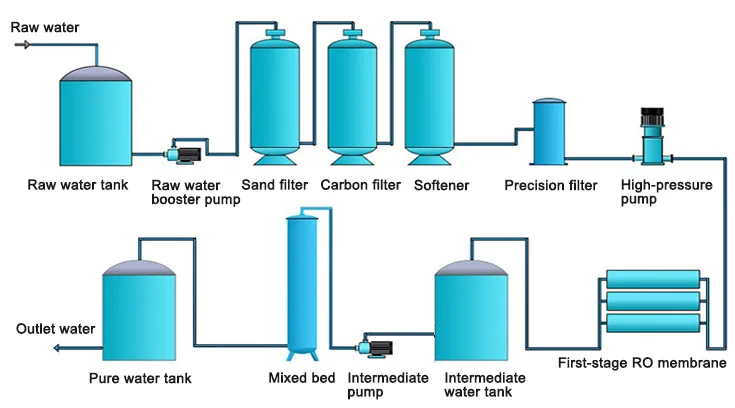
Domestic sewage treatment plant process flow
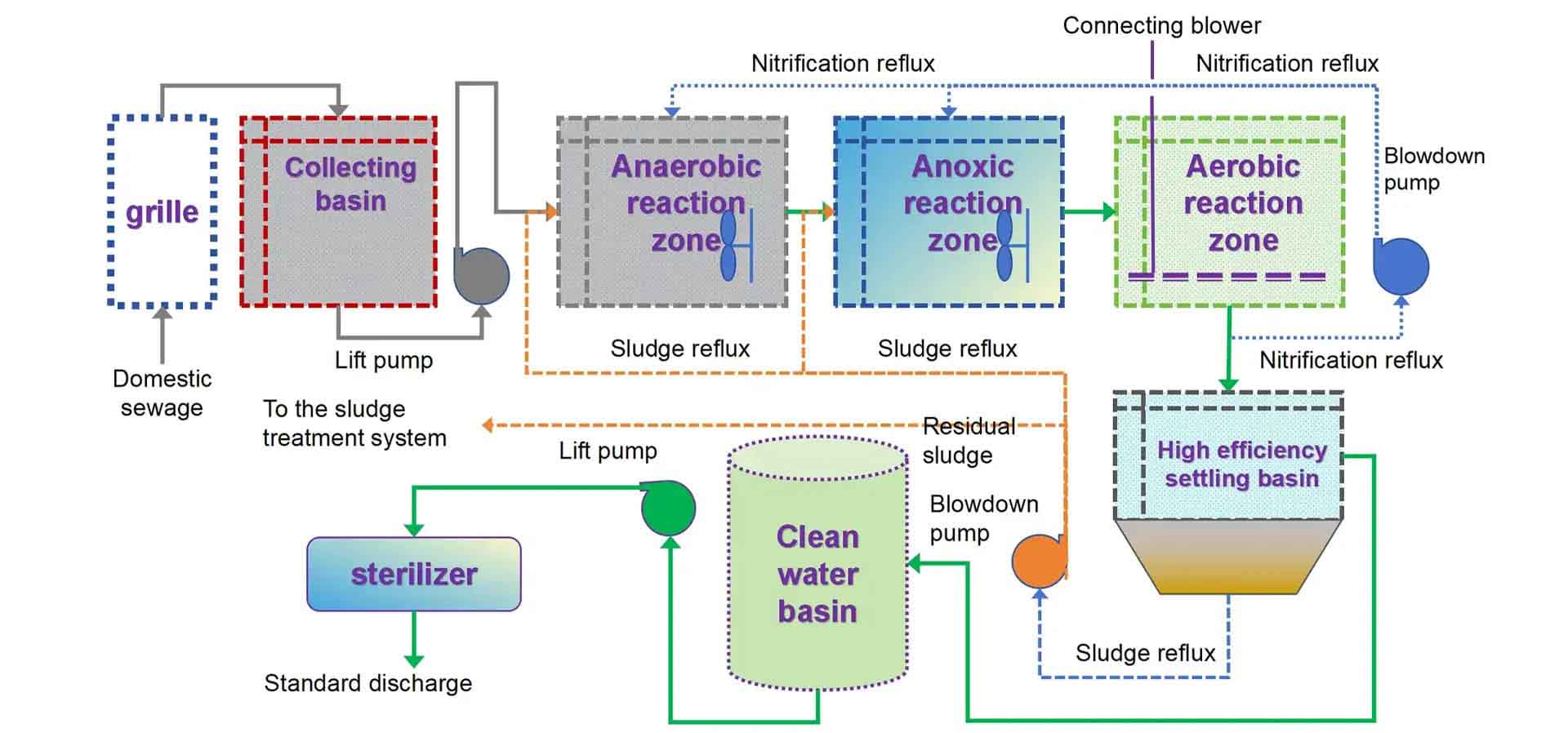
Production of equipment
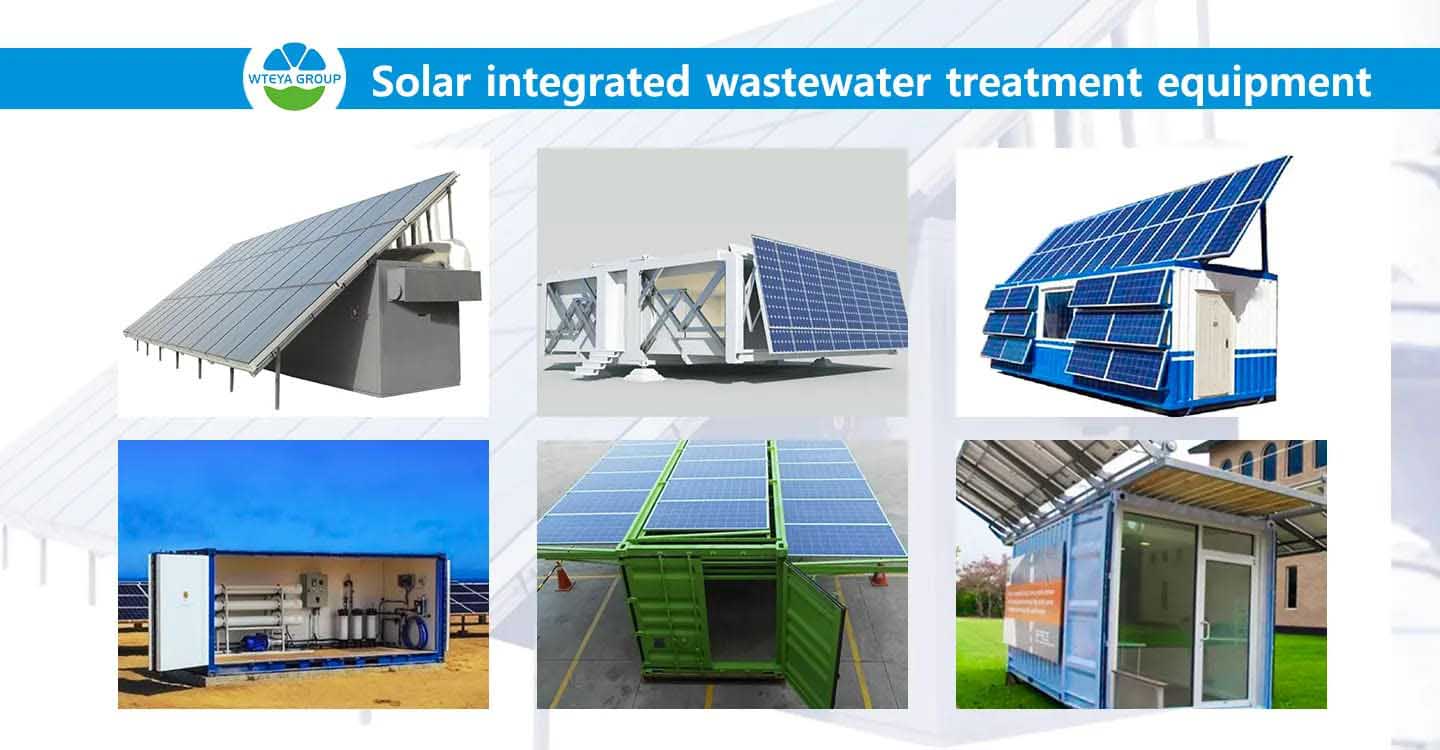
Capacity and size
Island operation configuration
Core functions: seawater desalination + domestic sewage treatment + photovoltaic energy storage system + diesel generator
Installed power: 16.65kw+2.5KW
Processing capacity:
1) Seawater desalination 2TPH, daily water output 10T.
2) Domestic sewage treatment 10TPD (using AO+MBR process)
3) Photovoltaic energy storage system: maximum photovoltaic power generation 36kw.h, energy storage battery: 60kw.h
Main equipment: 5000*2200*2400 (H), the host comes with 12 photovoltaic panels, and the remaining photovoltaic panels can be expanded on site according to actual needs.
Diesel generator: supplement the lack of solar energy
Unmanned area operation configuration
Core functions: pretreatment system + domestic drinking water system + domestic sewage treatment + photovoltaic energy storage system + diesel generator
Installed power: 2.42kw+2.95KW+2.5KW
Processing capacity:
1) Pretreatment system 1TPH (using MCR flat membrane process).
2) Drinking water system 1TPH (using primary RO process).
3) Domestic sewage treatment 10TPD (using AO+MBR process).
4) Photovoltaic energy storage system: maximum photovoltaic power generation 26kw.h, energy storage battery: 60kw.h
Main equipment: 5000*2200*2400 (H), the main unit comes with 12 photovoltaic panels, and the remaining photovoltaic panels can be expanded on site according to actual needs.
Diesel generator: to supplement the lack of solar energy
Effect drawing
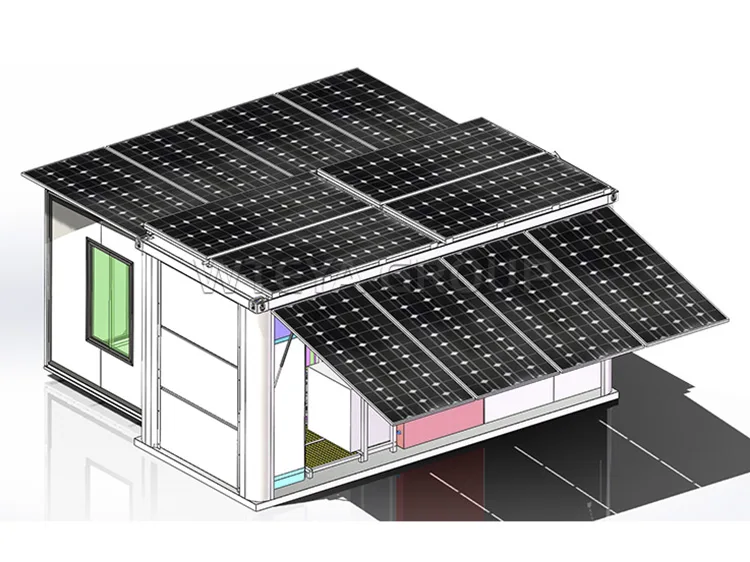
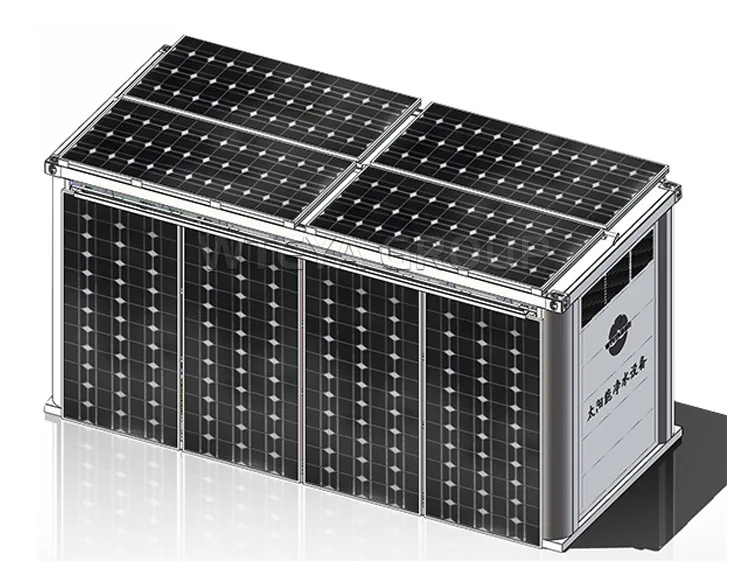
Frequently Asked Questions
|
Questions |
Solutions |
|
Reduced efficiency of solar photovoltaic panels: |
•Cause: There are stains, obstructions or aging on the surface of the photovoltaic panels. •Handling: Clean the photovoltaic panels regularly, remove obstructions, check and replace aged or damaged photovoltaic panels. |
|
Insufficient battery energy storage: |
•Cause: Battery aging, over-discharge or charging system failure. •Handling: Check the battery status and perform charging and discharging maintenance or replace the battery if necessary. Make sure the charging controller is working properly. |
|
Aeration system does not work or is inefficient:
|
•Cause: Aeration pump failure, aeration pipeline blockage or insufficient solar power supply. •Handling: Check whether the aeration pump is operating normally, clear the blocked pipeline, and ensure sufficient power supply. |
|
Control system failure:
|
•Cause: Circuit failure, sensor failure or control software problem. •Handling: Check the line connection, replace damaged sensors, and upgrade or restart the control system software. |
|
Decreased treatment efficiency of the biological treatment unit:
|
•Cause: Imbalance of biological flora, excessive influent load or improper nutrient ratio. •Handling: Adjust the influent flow rate and nutrient delivery, and re-cultivate or supplement biological strains if necessary. |
|
Outlet water quality does not meet the standard:
|
•Cause: Insufficient pretreatment, poor biological treatment effect, filtration system blockage or failure of disinfection unit. •Handling: Strengthen pretreatment, adjust biological treatment parameters, clean or replace filter media, and check the working status of disinfection equipment. |
|
System leakage:
|
•Cause: Loose or damaged pipe connections or aging seals. •Handling: Check and tighten or replace pipe connections, repair damaged parts, and replace aging seals. |
|
Winter operation problems:
|
•Cause: Low temperature causes photovoltaic panel efficiency to decrease, water body to freeze or equipment to crack. •Handling: Take antifreeze measures, such as insulation wrapping and adding antifreeze to ensure that the temperature of key components is appropriate. |
|
Drinking water outlet deteriorates
|
•Cause: MCR and RO membrane systems are blocked. •Handling: (1) Check whether the MCR membrane system is damaged and replace damaged membranes in time. (2) Clean the RO membrane system and replace the membrane core that is not cleaned properly or damaged in time. |
Previous: No More







